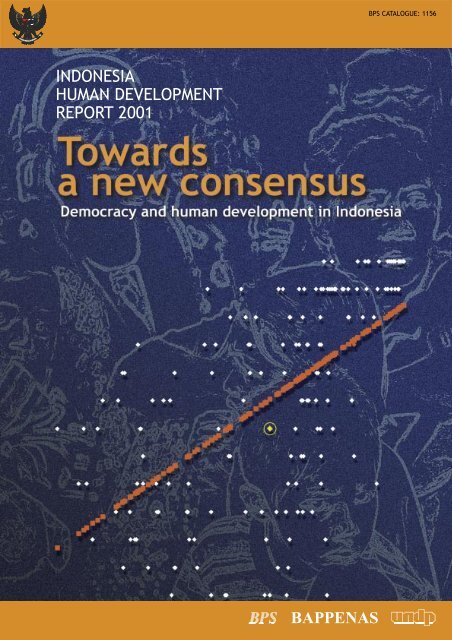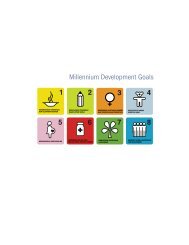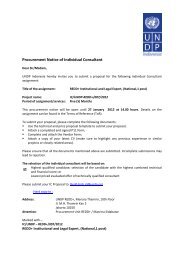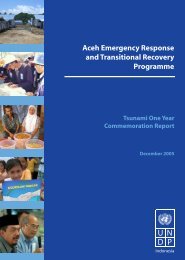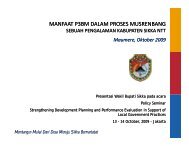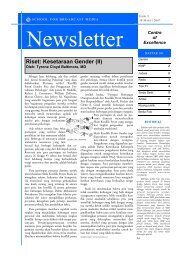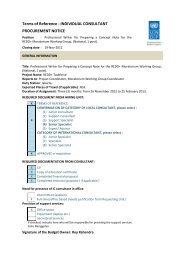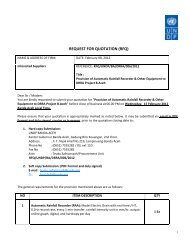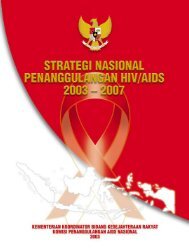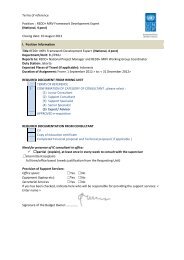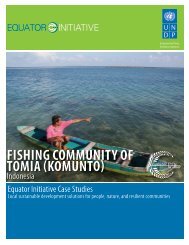Indonesia Human Development Report 2001 - UNDP
Indonesia Human Development Report 2001 - UNDP
Indonesia Human Development Report 2001 - UNDP
You also want an ePaper? Increase the reach of your titles
YUMPU automatically turns print PDFs into web optimized ePapers that Google loves.
BPS CATALOGUE: 1156<br />
INDONESIA<br />
HUMAN DEVELOPMENT<br />
REPORT <strong>2001</strong><br />
BAPPENAS
The diagram on the cover page depicts the correlation between<br />
democracy and human development. The white dots locate<br />
different countries according to their attainments on the human<br />
development and democracy indices. <strong>Indonesia</strong>'s position is<br />
indicated by the yellow circled dot.
INDONESIA<br />
HUMAN DEVELOPMENT<br />
REPORT <strong>2001</strong><br />
Towards<br />
a new consensus<br />
Democracy and human development in <strong>Indonesia</strong><br />
BPS-Statistics <strong>Indonesia</strong><br />
BAPPENAS<br />
<strong>UNDP</strong>
<strong>Indonesia</strong> <strong>Human</strong> <strong>Development</strong> <strong>Report</strong> <strong>2001</strong><br />
Towards a New Consensus: Democracy and <strong>Human</strong> <strong>Development</strong> in <strong>Indonesia</strong><br />
ISBN: 979-598-865-4<br />
Publication Number: 04400.0115<br />
BPS Catalogue: 1156<br />
Size: 210 x 297 mm<br />
No. of Pages: 156<br />
Manuscript: BPS-Statistics <strong>Indonesia</strong>, Bappenas, <strong>UNDP</strong><br />
Cover design: Bharata Kusuma<br />
Published Jointly by BPS-Statistics <strong>Indonesia</strong>, Bappenas and <strong>UNDP</strong> <strong>Indonesia</strong>
Foreword<br />
This is the first National <strong>Human</strong> <strong>Development</strong> <strong>Report</strong> for <strong>Indonesia</strong>. It has been preceded by<br />
National <strong>Human</strong> <strong>Development</strong> Index <strong>Report</strong>s in 1996, 1997 and 1999. As before, this has been a<br />
collaborative effort between the National <strong>Development</strong> Planning Agency (BAPPENAS), Statistics<br />
<strong>Indonesia</strong> (BPS) and the United Nations <strong>Development</strong> Programme (<strong>UNDP</strong>).<br />
The National <strong>Human</strong> <strong>Development</strong> <strong>Report</strong> is being published at an important juncture in <strong>Indonesia</strong>'s<br />
history, when the country is consolidating its nascent democracy while simultaneously striving to<br />
overcome the economic and financial crisis that overtook much of East Asia in 1997. The timing of<br />
this <strong>Report</strong> has dictated its concerns and contents. The primary focus is on the interrelationships<br />
between human development, democracy and economic progress in <strong>Indonesia</strong>. This <strong>Report</strong> is an<br />
ambitious and innovative undertaking compared to many other national human development reports,<br />
which focus on a single theme.<br />
This <strong>Report</strong> poses a question that is very much on the agenda of policy-makers in <strong>Indonesia</strong>: How<br />
can <strong>Indonesia</strong> achieve steady progress in all indicators of human development as it restructures its<br />
economy, refashions its governance institutions, and devolves decision-making to regions and localities?<br />
The answer, this <strong>Report</strong> argues, lies in building a new social consensus for <strong>Indonesia</strong> - a consensus<br />
that renews a shared commitment to human development, establishing that all <strong>Indonesia</strong>ns - as citizens<br />
of <strong>Indonesia</strong> - are entitled to nationally mandated standards of human development. Despite the odds<br />
confronting <strong>Indonesia</strong>, which this <strong>Report</strong> spells out in some detail, it is optimistic that current challenges<br />
can be surmounted.<br />
The <strong>Report</strong> is enriched by a wealth of new statistical tables. These include the <strong>Human</strong> <strong>Development</strong><br />
Index, along with its complementary measures: the <strong>Human</strong> Poverty Index, the Gender-related<br />
<strong>Development</strong> Index, and the Gender Empowerment Measure. These data are now available not just at<br />
the national but also at the provincial and district levels, allowing key human development issues and<br />
priorities to be publicized and debated throughout the country.<br />
These detailed statistics will be invaluable as <strong>Indonesia</strong> decentralizes much of the responsibility for<br />
development planning and policy to hundreds of individual districts. As with all such composite<br />
measures, however, the various human development indices need to be applied with care. Although<br />
they offer broad signposts toward human development needs and priorities, they must also be<br />
supplemented with all other quantitative and qualitative information that local authorities should have<br />
at their disposal.<br />
iii
This <strong>Report</strong> owes much to the many people and institutions that have taken part in numerous<br />
consultations contributing to its contents. Not all will agree with all of the argument or conclusions<br />
presented here. But we hope that readers will find the contents of this <strong>Report</strong> a compelling contribution<br />
to the policy debate on human development in <strong>Indonesia</strong>.<br />
Jakarta, 17 October <strong>2001</strong><br />
Kwik Kian Gie<br />
State Minister for <strong>Development</strong> Planning/<br />
Chairman of BAPPENAS<br />
Soedarti Surbakti<br />
Chairman of<br />
BPS-Statistics <strong>Indonesia</strong><br />
Bo Asplund<br />
Resident Representative<br />
<strong>UNDP</strong> <strong>Indonesia</strong><br />
The analysis and policy recommendations of this <strong>Report</strong> do not necessarily reflect the views of BAPPENAS, BPS-<br />
Statistics <strong>Indonesia</strong> or <strong>UNDP</strong>. The <strong>Report</strong> was commissioned by <strong>UNDP</strong> under project INS/99/002 commonly known<br />
as UNSFIR (the United Nations Support Facility for <strong>Indonesia</strong> Recovery). The principal partner and executing agency<br />
of this project within the Government of <strong>Indonesia</strong> is Badan Perencanaan Pembangunan Nasional (BAPPENAS). The<br />
present report is the outcome of a series of open consultations around an initial draft prepared by an UNSFIR team led<br />
by Satish C. Mishra. The statistical tables of the indicators and indices presented in this <strong>Report</strong> were computed by a<br />
team of BPS-Statistics <strong>Indonesia</strong>.<br />
This <strong>Report</strong> has been prepared jointly by<br />
a <strong>UNDP</strong>-Bappenas Project commonly known as UNSFIR and BPS-Statistics <strong>Indonesia</strong><br />
Team Leader:<br />
Satish C. Mishra.<br />
Drafting Team:<br />
Anis Chowdhury, Iyanatul Islam, Widjajanti I. Suharyo,<br />
Moh. Zulfan Tadjoeddin, Puguh B. Irawan.<br />
Statistical Team:<br />
Wynandin Imawan, Arizal Ahnaf, Uzair Suhaimi, Tono Iriantono, Tolkhah Mansyur, Nurma Midayanti,<br />
Zuraini, Ahmad Avenzora, Yulin Haniati, Aldian Taloputra.<br />
Administrative and Secretarial Support:<br />
Brasukra G. Sudjana, Diana Venturini, Syane Luntungan, Rosana Erinaldi, Cut Dian Rahmi.<br />
Editor:<br />
Peter Stalker.<br />
Desktop Composition and Production Management:<br />
Bharata Kusuma.<br />
iv INDONESIA HUMAN DEVELOPMENT REPORT <strong>2001</strong>
Acknowledgements<br />
This <strong>Report</strong> has evolved as a collaborative process<br />
that has benefited from the skill, energy and commitment<br />
of many people, including those directly involved in its<br />
production and many others who have generously offered<br />
their time to comment and contribute at various stages.<br />
The <strong>Report</strong> benefited greatly from the general support<br />
of BAPPENAS in its preparation – reflecting its keenness<br />
to adopt a wider consultative process. BAPPENAS also<br />
facilitated a major consultation meeting to discuss the main<br />
ideas in the <strong>Report</strong> and helped to put this report in the<br />
broader policy setting. The team also expresses its<br />
gratitude to the BAPPENAS staff who offered ideas and<br />
inputs throughout the drafting process, in particular to<br />
Mr. Djunaedi Hadisumarto, Mr. Soekarno Wirokartono,<br />
Mrs. Leila Ratna Komala, Mr. Dedi M. Masykur, Ms. Nina<br />
Sardjunani, Mr. Arum Atmawikarta, Mr. Daroedono, Mr.<br />
Bima Wibisana, Mr. Bambang Prijambodo, Mr. Lukita<br />
Dinarsyah Tuwo, Mr. Bambang Widianto, Mr. Joyo<br />
Winoto, Mr. Max H. Pohan, Mr. Ikhwanuddin Mawardi,<br />
Ms. Yohanawati, Mr. Guntur, Mr. Sanjoyo and their<br />
colleagues in BAPPENAS.<br />
The team is especially grateful for the close<br />
collaboration with BPS-Statistics <strong>Indonesia</strong>. BPS<br />
shouldered the responsibility of preparing the human<br />
development indicators and indices presented in this<br />
<strong>Report</strong>, and also organized workshops on data refinement<br />
and verification. Thanks in particular to Mrs. Soedarti<br />
Surbakti, Mr. Kusmadi Saleh, Mr. Wynandin Imawan, Mr.<br />
Toto E. Sastrasuanda, Mr. Uzair Suhaimi, Mr. Tolkhah<br />
Mansyur, Ms. Nurma Midayanti along with other staff at<br />
both the central and regional offices who have contributed<br />
to the refinement of the data.<br />
Many individuals and institutions have actively<br />
participated in the discussions or consultations and shared<br />
their views and comments. Lack of space precludes<br />
naming all of them here, but we would like to recognize<br />
especially the contributions of Mr. Fachry Ali (LSPEU<br />
<strong>Indonesia</strong>), Mr. H.S. Dillon (Poverty Commission),<br />
Mr. Iqbal Djajadi (Sociology Laboratory, University of<br />
<strong>Indonesia</strong>), Mrs. Mayling Oei Gardiner (UI), Mr. Peter<br />
Gardiner (Insan Hitawasana Sejahtera), Mr. Anton<br />
Gunawan (Citibank), Mr. Andi Hakim Nasution (STT<br />
Telkom), Mr. Halide (Hasanudin University), Mr. Jim Hope<br />
(USAID), Mr. Terry Hull (ANU), Ms. Jacqueline Pomeroy<br />
(World Bank), Ms. Haning Romdiati (PPT-LIPI), Mr.<br />
Satoto (UNDIP), Mr. Firdaus A. Siddik (Rothschild<br />
<strong>Indonesia</strong>), Mr. Hananto Sigit (BPS), Mr. Soekandi (PPK-<br />
UGM), Ms. Nunik Sriyuningsih (PSW Diponegoro<br />
University), Ms. Emmy Susanti (PSW Airlangga<br />
University), Mr. Bambang Heru Susanto (BPS East Java),<br />
Ms. Mely G. Tan (Unika Atmajaya), Mr. Soni Sumarsono<br />
and Ms. Nining (Ministry of Home Affairs) and Ms. Rahmi<br />
Untoro (Ministry of Health). The team must also express<br />
its special thanks to the discussants in the BAPPENAS<br />
consultation: Mr. Ichlasul Amal (UGM), Mr. Sugeng<br />
Bahagijo (INFID), Mr. Fasli Djalal (Ministry of Education),<br />
Mr. Tommy Legowo (CSIS), and Mr. Soekirman (IPB).<br />
The team also wishes to thank many individuals from<br />
the various UN agencies, who commented on the draft,<br />
including: Mr. Iftikar Ahmed (ILO), Mr. Stephen C. Hill<br />
(UNESCO), Mr. Rolf C. Carriere and Mr. Stephen J.<br />
Woodhouse (UNICEF), Mr. Shafiq Dhanani and Mr. Asif<br />
Hasnain (UNIDO). From the <strong>Human</strong> <strong>Development</strong> <strong>Report</strong><br />
Office in New York, Mr. Omar Noman and Mr. Richard<br />
Ponzio offered helpful comments on the drafts.<br />
From the inception of the <strong>Report</strong> many people in<br />
<strong>UNDP</strong>-<strong>Indonesia</strong> have offered suggestions and support.<br />
We would like to mention in particular Mr. Andre Klap,<br />
Ms. Bona Siahaan, Mr. Kevin Evans, Mr. Carl Hessic,<br />
Ms. Mette Jensen and Ms. Barbara Brouwer. We owe<br />
special thanks to Mr R. Sudarshan for his consistent<br />
interest in the <strong>Report</strong> and his spirit of intellectual<br />
engagement. This has helped us refine many initial<br />
hunches and ideas. Last but not least, the team is especially<br />
grateful to Mr. Ravi Rajan, former <strong>UNDP</strong> Resident<br />
Representative, who initiated the preparation of the report<br />
as well as provided useful comments on an early draft.<br />
We thank Mr. Bo Asplund, the current <strong>UNDP</strong> Resident<br />
Representative, for his continuing interest and<br />
encouragement.<br />
v
Abbreviations<br />
BAPPENAS : Badan Perencanaan Pembangunan Nasional - National Planning Board<br />
Bimas : Bimbingan Masal - Mass (Agriculture) Extension Programme<br />
BMI : Body Mass Index<br />
BPS : Badan Pusat Statistik - Statistics <strong>Indonesia</strong><br />
GEM : Gender Empowerment Measure<br />
GNP : Gross National Product<br />
GDP : Gross Domestic Product<br />
GDI : Gender-related <strong>Development</strong> Index<br />
GRDP : Gross Regional Domestic Product<br />
HDI : <strong>Human</strong> <strong>Development</strong> Index<br />
HDR : <strong>Human</strong> <strong>Development</strong> <strong>Report</strong><br />
HPI : <strong>Human</strong> Poverty Index<br />
Inmas : Intensifikasi Masal - Mass (Agriculture) Intensification Programme<br />
Inpres : Instruksi Presiden - Presidential Instruction<br />
NGO : Non-Government Organization<br />
PKK : Pendidikan Kesejahteraan Keluarga - Family Welfare Movement<br />
Puskesmas : Pusat Kesehatan Masyarakat - Health Centre<br />
Sakernas : Survai Tenaga Kerja Nasional - National Labour Force Survey<br />
Susenas : Survai Sosial Ekonomi Nasional - National Socio-Economic Survey<br />
SSN : Social Safety Net<br />
<strong>UNDP</strong> : United Nations <strong>Development</strong> Programme<br />
UNICEF : United Nations Children's Fund<br />
vi INDONESIA HUMAN DEVELOPMENT REPORT <strong>2001</strong>
Contents<br />
EXECUTIVE SUMMARY<br />
Towards a new consensus 1<br />
CHAPTER 1<br />
<strong>Human</strong> <strong>Development</strong> Challenges in a Democratic, Decentralized <strong>Indonesia</strong> 5<br />
Achievements in human development 6<br />
Poverty 7<br />
Inequality 8<br />
Gender disparity 8<br />
Inter-provincial disparity 9<br />
Impact of the crisis 10<br />
Challenges of human development 11<br />
Annex 1.1: Trends in human development at provincial level: 1990-1999 14<br />
Annex 1.2: Monitoring human development and human poverty indicators, 1990-1999 15<br />
CHAPTER 2<br />
Consolidating <strong>Indonesia</strong>'s Democracy 16<br />
Trading freedom for progress 17<br />
The road to democracy 17<br />
The democratic tide 19<br />
Democracy under strain 20<br />
Weak political parties 20<br />
The escalation of social conflict 21<br />
The demise of social consensus 22<br />
Is democracy a luxury? 22<br />
The democratic dividend 24<br />
Annex 2.1: <strong>Human</strong> development, democracy and economic growth 25<br />
CHAPTER 3<br />
Understanding <strong>Indonesia</strong>'s transformation 27<br />
Decades of transformation 28<br />
Employment 29<br />
vii
Income inequality 29<br />
Education 29<br />
Health care 30<br />
Food Policy 31<br />
Protection of the development budget 32<br />
Income poverty 32<br />
The disappearing miracle 32<br />
A changing production environment 32<br />
A new macroeconomic environment 33<br />
CHAPTER 4<br />
Rebuilding the <strong>Indonesia</strong>n miracle 35<br />
A collapsing economy 35<br />
Shrinking employment and incomes 36<br />
Income distribution maintained 37<br />
A dip in human development 38<br />
Keeping children at school 38<br />
Cuts in the health budget 39<br />
Stagnation in human poverty 39<br />
Reworking the miracle 39<br />
Coping with globalization 40<br />
Investing in human development 41<br />
CHAPTER 5<br />
Putting people first: A compact for human development 43<br />
Responsibility passes to districts 44<br />
A compact on human development 46<br />
A mission statement 47<br />
<strong>Human</strong> development standards 47<br />
The minimalist approach 47<br />
The universalist approach 48<br />
Can the regions catch up 50<br />
Public deliberation 51<br />
A new consensus 51<br />
Endnotes 52<br />
Bibliography 55<br />
BOXES<br />
1.1. What human rights add to human development 7<br />
1.2. <strong>Human</strong> <strong>Development</strong> Index 10<br />
1.3. Women in <strong>Indonesia</strong> 13<br />
viii INDONESIA HUMAN DEVELOPMENT REPORT <strong>2001</strong>
1.4. Impact of the Crisis on Females 13<br />
2.1. Democratic transitions in Southeast Asia 20<br />
2.2. Principles of good governance in <strong>Indonesia</strong> 23<br />
4.1. <strong>Indonesia</strong>'s financial crisis in historical perspective 36<br />
5.1. Decentralization 44<br />
5.2. Outcomes of decentralization around the world 45<br />
5.3. Applying the <strong>Human</strong> <strong>Development</strong> Index in <strong>Indonesia</strong> 46<br />
TABLES<br />
1.1. Population below selected poverty lines, 1996-99 11<br />
2.1. Elections in <strong>Indonesia</strong>n History 18<br />
2.2. Social violence, 1945-1999 21<br />
3.1. <strong>Indonesia</strong>: Gini ratio of household expenditure across provinces, 1976 - 1999 30<br />
4.1. L-index of per-capita household expenditure, 1990-1999 37<br />
4.2. Poverty severity index, 1996-1999 37<br />
4.3. Number of teachers (thousands) 38<br />
4.4. School enrolment and adult literacy, 1993-1998 38<br />
4.5. Children's use of health facilities 39<br />
4.6. Public expenditure on health and education 41<br />
5.1. Years required for provinces to reach 1999 national average based on past trends 48<br />
5.2. Time required from 1993 to reach selected international development goals, based on<br />
1993-1999 trends 49<br />
5.3. Time required in years to reach selected universal targets based on 1990-1999 trends 50<br />
FIGURES<br />
1.1. <strong>Human</strong> <strong>Development</strong> Index (HDI), 1975-1999 6<br />
1.2. <strong>Indonesia</strong>: <strong>Human</strong> <strong>Development</strong> Indicators 6<br />
1.3. Trend in Poverty, 1970-1999 8<br />
1.4. Trends in Interpersonal Inequality of Expenditure, 1975-1999 8<br />
1.5a. Percentage of Illiteracy by Gender (Total) 9<br />
1.5b. Percentage of Illiteracy by Gender (Age 10-14) 9<br />
1.6. Relationship between Rank of HDI and GDI, 1990 and 1996 11<br />
1.7. Selected Social Indicators in 1995 11<br />
1.8. <strong>Human</strong> <strong>Development</strong> Index of selected ASEAN countries 12<br />
1.9. Public Expenditure on Health, 1996-98 (as % of GDP) 12<br />
1.10. Public Expenditure on Education, 1996-98 (as % of GNP) 12<br />
2.1. Urbanization and Literacy, 1930 - 2000 17<br />
2.2. Global picture of democratic governments elected by universal suffrage 19<br />
2.3. Democracy and income 22<br />
2.4. Democracy and the human development index 22<br />
3.1. Long-term real GDP growth, 1951-2000 28<br />
3.2. Employment by sector 29<br />
3.3. Education and health expenditure, 1969 - 1998 30<br />
3.4. Primary enrolment in Southeast Asia, 1965-1990 30<br />
ix
3.5. Infant mortality and life expectancy 31<br />
3.6. Maternal mortality, 1988-1993 31<br />
3.7. Real and nominal wages in manufacturing, 1986-1989 32<br />
4.1. Per capita GDP growth scenarios 36<br />
4.2. Inter-districts disparities, 1998 Lorenz curves 37<br />
4.3. Gini coefficients above and below the poverty line, 1996-1999 38<br />
4.4. Access to safe sanitation 41<br />
5.1. Literacy rate by province, 1999 47<br />
HUMAN DEVELOPMENT INDICATORS AND INDICES<br />
The concept and measurement of human development 64<br />
What do the human development indices reveal? 71<br />
1. <strong>Human</strong> <strong>Development</strong> Index (HDI) by Province, 1996 and 1999 78<br />
2. Gender-related <strong>Development</strong> Index (GDI) by Province, 1996 79<br />
3. Gender-related <strong>Development</strong> Index (GDI) by Province, 1999 80<br />
4. Gender Empowerment Measure (GEM) by Province, 1996 and 1999 81<br />
5. <strong>Human</strong> Poverty Index (HPI) by Province, 1995 and 1998 82<br />
6. <strong>Human</strong> <strong>Development</strong> Index (HDI) by District, 1996 and 1999 83<br />
7. Gender-related <strong>Development</strong> Index (GDI) by District, 1999 90<br />
8. Gender Empowerment Measure (GEM) by District, 1999 97<br />
9. <strong>Human</strong> Poverty Index (HPI) by District, 1998 104<br />
10. Health Condition by District, 1999 111<br />
11. School Attendance by District, 1999 118<br />
12. Housing Condition by District, 1999 125<br />
13. Economic Performance by District, 1995-1998 132<br />
14. Labour Force and Poverty Conditions by District, 1999 139<br />
Technical notes 147<br />
Definitions of statistical terms 154<br />
x INDONESIA HUMAN DEVELOPMENT REPORT <strong>2001</strong>
EXECUTIVE SUMMARY<br />
Towards a new consensus<br />
This report puts people first. It argues that<br />
progress in human development is not just<br />
essential in itself but also lays the foundations for a<br />
stable and unified democracy, and promotes the<br />
transition towards a rules-based market economy<br />
that can permit sustained economic growth. In a<br />
country as large and diverse as <strong>Indonesia</strong>, however,<br />
this can only be achieved through extensive national<br />
and regional consultations – leading to a new<br />
consensus and a shared commitment to human<br />
development.<br />
Until the onset of the financial crisis <strong>Indonesia</strong> had<br />
taken enormous strides in many aspects of human<br />
development. From 1975 to the second half of the 1990s<br />
the country's human development index (HDI) rose<br />
steadily, until the sudden dip in 1998. But the HDI tells<br />
only a part of the story. If it also reflected the extent of<br />
human rights and freedoms, the trajectory would look<br />
much less impressive, because for three decades the New<br />
Order regime had forced <strong>Indonesia</strong>ns to trade political<br />
freedom for economic progress.<br />
The purpose of this National <strong>Human</strong> <strong>Development</strong><br />
<strong>Report</strong> is to assess <strong>Indonesia</strong>'s democratic and economic<br />
transitions – to demonstrate why the country is unlikely<br />
to make enduring economic progress, or consolidate its<br />
democracy, unless it can make a firm commitment to<br />
human development. A consensus among the regions on<br />
citizens' rights to human development can also act as a<br />
centrifugal force for national unity.<br />
Achievements and challenges<br />
Over the past three decades <strong>Indonesia</strong> has had laudable<br />
achievements in human development. These range from<br />
reductions in poverty and inequality to increases in life<br />
expectancy and literacy. Infant mortality, for example,<br />
declined substantially, following improvements in access<br />
to health care and sanitation. At the same time there have<br />
been considerable improvements in the status of women:<br />
male-female gaps have been narrowing at all levels of<br />
education, and women's earnings have been increasing<br />
as a proportion of earned family income. Meanwhile<br />
disparities between the provinces have also been shrinking.<br />
The sudden and unexpected crisis of the late 1990s<br />
dealt a serious blow to <strong>Indonesia</strong>'s journey to progress.<br />
For most people the immediate and sharpest impact of<br />
the crisis has been through inflation. Between 1997 and<br />
1998 inflation surged from 6% to 78%, while real wages<br />
fell by around one-third. As a result there was a sharp<br />
increase in poverty. Between 1996 and 1999 the proportion<br />
of people living below the poverty line jumped from 18%<br />
to 24%. At the same time, poverty became more severe<br />
as the incomes of the poor as a whole fell further below<br />
the poverty line.<br />
The crisis seems to have affected women and children<br />
more adversely. For many families where both men and<br />
women were working before the crisis, women were<br />
forced to work longer hours as men lost their jobs.<br />
Declines in income also reduced families' access to health<br />
care and other basic services. There is some evidence of<br />
increased domestic violence due to economic stress<br />
following the crisis.<br />
The overall impact of the crisis was reflected in the<br />
deterioration of <strong>Indonesia</strong>'s human development index<br />
(HDI) – largely the result of the drop in real incomes.<br />
Meanwhile, although the <strong>Human</strong> Poverty Index (HPI)<br />
remained stable, there were reductions in access to health<br />
services.<br />
In the aftermath of the economic crisis, <strong>Indonesia</strong> faces<br />
serious challenges of human development. The long-term<br />
outlook for public services is poor. Because of the decision<br />
to bail out the banks the government is now deep in debt.<br />
Effectively the population as a whole has assumed a<br />
massive burden that will require them to pay higher taxes<br />
and have less effective public services.<br />
In the short-term, the tight-budgetary situation poses<br />
a threat to social spending. Any cut in social spending<br />
will have serious long-term implications, especially since<br />
<strong>Indonesia</strong> has historically lagged behind her neighbours,<br />
and a large number of people remain vulnerable to poverty.<br />
Consolidation of <strong>Indonesia</strong>'s democracy<br />
<strong>Indonesia</strong> has already experienced several forms of<br />
government, and different shades of democracy – the<br />
most recent change being the collapse of the autocratic<br />
New Order regime and the successful elections<br />
EXECUTIVE SUMMARY<br />
1
of June 1999. Is this just another swing of the pendulum,<br />
to be followed soon by another swing backwards?<br />
Certainly there is no cause for complacency: The twentieth<br />
century saw dozens of democratic openings that were<br />
extinguished by coups and military takeovers. But the tide<br />
of history is in the other direction. Now that <strong>Indonesia</strong><br />
has joined the democratic fold, the proportion of world<br />
population enjoying democratic government has risen to<br />
63%.<br />
However, <strong>Indonesia</strong>n democracy still remains fragile.<br />
The political parties are weak and inexperienced. Several<br />
provinces are being torn apart by social conflict. Added<br />
to this is the country's ambitious schedule for<br />
decentralization that will make government an even more<br />
complex affair.<br />
The political parties are weak because they are based<br />
not on distinctive principles or policies but on sectional<br />
interests and personalities. Different governing coalitions<br />
seem therefore to be alternative permutations of wise<br />
individuals. Party formation is also weak in the country at<br />
large, and there are few channels through which people<br />
can bring pressure to bear on the institutions of the state,<br />
especially the state bureaucracy.<br />
In these circumstances, people vent their frustrations<br />
in other ways. In such a large and diverse country there<br />
is always the danger that conflicts over employment, or<br />
land, or other natural resources will cleave along ethnic<br />
or religious lines. When the New Order government<br />
disappeared, a new political landscape opened up, allowing<br />
many old disputes to resurface. This is having a deeply<br />
corrosive effect – undermining confidence in political<br />
institutions and damaging the prospects for continuing<br />
<strong>Indonesia</strong>'s economic reforms.<br />
It might be argued that the most practical option is for<br />
<strong>Indonesia</strong> to unite once more behind a single charismatic<br />
figure. But this could prove even more dangerous. Rather<br />
than ensuring national integrity a military-backed autocrat<br />
is more likely to provoke the kind of determined resistance<br />
that will sever national ties across the archipelago forever.<br />
And the economic implications are equally chilling. The<br />
international companies on which <strong>Indonesia</strong>'s economy<br />
depends are now under intense consumer pressure on<br />
labour rights. If <strong>Indonesia</strong>'s international human rights<br />
ratings take a dive, so too will its economy. Nowadays it<br />
is human development grounded in democracy that pays<br />
economic dividends.<br />
Understanding <strong>Indonesia</strong>'s transformation<br />
Until the outbreak of the economic crisis in 1997,<br />
<strong>Indonesia</strong> was one of East Asia's miracle economies,<br />
combining high growth with an equitable distribution of<br />
income – first with the green revolution in rice in the<br />
mid-1970s, then with a rapid expansion of labour-intensive<br />
industries in the mid-1980s, and later with the<br />
establishment of a manufacturing export base in the 1990s.<br />
At the outset <strong>Indonesia</strong> had the advantage of a relatively<br />
equitable distribution of income. In the rural areas this<br />
was because land ownership had traditionally been<br />
fragmented. But urban areas were not much wealthier.<br />
Although nominal incomes were higher these were offset<br />
by high housing costs.<br />
Moreover this income distribution was largely<br />
maintained. Even in the late 1980s when growth averaged<br />
over 8% annually, there was no serious increase in<br />
inequality. Meanwhile, standards of education and health<br />
had been rising, thanks in part to the government's efforts<br />
to protect the development budget even when its income<br />
fluctuated along with the price of oil. The government's<br />
food policy also helped reduce poverty and inequality –<br />
on the one hand establishing a floor price to support<br />
farmers, on the other hand stabilizing prices at a reasonable<br />
level for urban consumers. This combination of rapid<br />
economic growth and equitable distribution of income<br />
resulted in a steep reduction in income poverty – from<br />
over 40% in 1976 to 11% in 1996.<br />
By the second half of the 1990s, however, there were<br />
already signs that the golden age of <strong>Indonesia</strong>n economic<br />
growth was coming to a close. There were two main<br />
sets of issues: the first was the changing production<br />
environment; the second the changing macroeconomic<br />
environment.<br />
A changing production environment<br />
<strong>Indonesia</strong>'s former structure of production could no<br />
longer be relied upon to produce steady growth. Neither<br />
agriculture nor industry could continue in the same<br />
fashion.<br />
• Stagnating agriculture – One of the features of the<br />
earlier period was a steady increase in agricultural productivity.<br />
But land is now scarcer, and it will be difficult<br />
to drive rice yields up much further.<br />
• More capital-intensive production – Many industries,<br />
including textiles, wood products and food are becoming<br />
steadily more capital intensive.<br />
• Slower export growth – By the end of the 1980s the<br />
trading environment was becoming tougher, partly as a<br />
result of recessions in the importing countries, as well as<br />
fiercer competition from other low-wage economies.<br />
• Growth of the formal labour market – The increase in<br />
formal employment has raised new issues of social protection.<br />
Without unemployment insurance, people who<br />
lose their jobs can also see their skills erode if they have<br />
to resort to work in the informal sector or agriculture.<br />
2 INDONESIA HUMAN DEVELOPMENT REPORT <strong>2001</strong>
A new macroeconomic environment<br />
At the same time <strong>Indonesia</strong> was increasingly exposed<br />
to the demands and moods of the international money<br />
markets.<br />
• Savings and investment – In the 1990s <strong>Indonesia</strong>'s<br />
savings-to-GDP ratio reached an upper ceiling of around<br />
29%. Further investment will probably have to come from<br />
foreign portfolio investment – with the attendant risks of<br />
volatility.<br />
• Exchange rate management – The more <strong>Indonesia</strong><br />
depends on foreign capital the more its exchange rate and<br />
its growth rates will fluctuate.<br />
• Monetary and fiscal policy – Efforts to control inflation<br />
have concentrated on constraining public expenditure<br />
– with serious implications for human development.<br />
It might be better to accept a higher level of inflation which<br />
might hurt the poor less than cuts in public services.<br />
Rebuilding the <strong>Indonesia</strong>n miracle<br />
If <strong>Indonesia</strong> is to rekindle both economic and human<br />
development, it will have to build a different economic<br />
structure. Thus far the government has resisted the<br />
temptation to try to insulate itself from global pressures<br />
and has shown a resolute determination to maintain open<br />
regimes. This is the only feasible option. If <strong>Indonesia</strong> is<br />
to progress economically it will have to engage in a third<br />
round of industrial diversification, stepping up the<br />
technology ladder to produce goods that embody higher<br />
levels of productivity. And most of this innovation will<br />
have to come from the stimulus of foreign investment<br />
and technology transfer.<br />
With an open and more capital-intensive economy,<br />
however, <strong>Indonesia</strong> is almost certainly going to see a further<br />
increase in inequality. And if the current pattern of<br />
distribution of industrial activity remains the same – with<br />
most concentrated in Java – then there are likely to be<br />
greater disparities between different provinces and<br />
districts.<br />
Rekindling <strong>Indonesia</strong>'s economic miracle will mean<br />
achieving higher levels of productivity but also doing so<br />
within the kind of stable social and political environment<br />
on which productive enterprises rely. Fortunately both<br />
objectives can be achieved through the same basic policy<br />
– substantial and sustained investment in human<br />
development. Without a more highly qualified workforce,<br />
<strong>Indonesia</strong> will be unable to benefit even from the lowerlevel<br />
spin-off effects of higher technology production.<br />
And without delivering better standards of health and other<br />
social services, social unrest is likely to persist.<br />
This will require much greater investment in education.<br />
<strong>Indonesia</strong> is spending only around 1.4% of GNP on<br />
education, compared with a global average of 4.5%. Health<br />
should also be a priority. This is not just a question of<br />
providing better health services. Even some of the more<br />
basic needs like sanitation are not being met –<br />
compromising not just the health but also the nutritional<br />
standards of <strong>Indonesia</strong>'s children. Another emerging issue<br />
is social protection, and in particular some form of<br />
unemployment insurance.<br />
<strong>Indonesia</strong> now has to pursue human development,<br />
while deep in debt, restructuring its economy, and coping<br />
with a more competitive and unstable economic<br />
environment. The key, however, is to recognize how all<br />
these issues connect – the social, the economic and the<br />
political – and to bring this recognition to the forefront of<br />
public consciousness.<br />
Putting people first: A compact for regional<br />
decentralization<br />
<strong>Indonesia</strong> urgently needs to build a new social<br />
consensus. Already there has been a fundamental shift in<br />
values and perceptions – and an explosion in expectations:<br />
millions of people sense the possibility for a different kind<br />
of future both for themselves and for <strong>Indonesia</strong> in the<br />
world. In short they have become more aware of their<br />
rights – not just political rights but ‘economic’ rights – to<br />
food, say, or to health, or to work. When people emphasize<br />
their regional or ethnic identity they are not just demanding<br />
greater autonomy or political freedom, they are also saying<br />
that some of their most basic social and economic rights<br />
have yet to be fulfilled.<br />
How can the Government of <strong>Indonesia</strong> possibly afford<br />
to fulfil such rights? Similar doubts have arisen in poor<br />
countries all over the world, where the promotion of<br />
economic rights has foundered on the hard question of<br />
who has a duty to fulfil them. But all rights do not have to<br />
be paired with corresponding duties. A better approach is<br />
to see the assertion of rights as the first step towards<br />
fulfilment and of building acceptance and support.<br />
In future, more of these rights are going to have to be<br />
fulfilled at the district level. <strong>Indonesia</strong> has embarked on a<br />
radical programme of decentralization that has raised a<br />
host of difficult questions – particularly about the fiscal<br />
relationship between the centre and the regions – as well<br />
as the prospect of widening gaps if the better endowed<br />
districts can pull further ahead of the rest of the country.<br />
How can <strong>Indonesia</strong> ensure that decentralization does<br />
indeed cement national cohesion and deepen national<br />
commitment to human development? One option is to<br />
establish a new social compact: an agreement that all<br />
<strong>Indonesia</strong>ns – as <strong>Indonesia</strong>ns – are entitled to nationally<br />
mandated standards of human development. With these<br />
EXECUTIVE SUMMARY<br />
3
in place, regional cultural and ethnic diversity are not<br />
divisive elements but rather the building blocks of a strong<br />
and coherent nation.<br />
Such a compact should be based on a clear mission<br />
statement that establishes the primacy of human<br />
development, while highlighting the importance of a<br />
productive partnership between central and regional<br />
governments.<br />
The compact must also be based on a set of standards<br />
to which all districts should aspire. The best approach<br />
would be to adopt the international standards and norms<br />
that have been established as a result of a series of United<br />
Nations conferences held during the 1990s – on poverty,<br />
for example, education, gender disparities and health.<br />
<strong>Indonesia</strong> has already incorporated many of these into<br />
its national plan documents. Now these goals could be<br />
regionalized and merged with other important universal<br />
goals – to achieve 100% literacy, for example, and 100%<br />
access to safe water. Another possibility is to include<br />
<strong>Indonesia</strong>'s stated intention to have all children complete<br />
nine years of basic education.<br />
Extrapolating from recent progress suggests that<br />
<strong>Indonesia</strong> as a whole could reach these targets within the<br />
international target date of 2015. But when broken down<br />
by region the picture is less optimistic: in the case of<br />
poverty, for example, 18 provinces will miss the 2015<br />
target date. This underlines the importance of drawing up<br />
a human development compact. If these are basic rights<br />
then they must be achieved by all <strong>Indonesia</strong>ns.<br />
Democratic values and norms can only emerge from<br />
deep and extensive consultation, especially when vital<br />
decisions are scattered across more than three hundred<br />
districts of a vast archipelago. One way to trigger such<br />
deliberations would be to hold a ‘National Social Summit’<br />
– to agree on national standards, the entitlements for each<br />
region, and the necessary plan of action.<br />
In sum, <strong>Indonesia</strong> faces enormous and diverse<br />
challenges – consolidating democracy, addressing<br />
regional conflicts, and regenerating the economy. But<br />
a common thread runs through them all. They will<br />
only be achieved if they are based on common values<br />
and a new consensus – on a shared commitment to<br />
human development.<br />
4 INDONESIA HUMAN DEVELOPMENT REPORT <strong>2001</strong>


